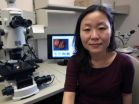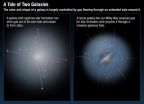(Press-News.org) The removal of rare tumor cells circulating in the blood might be possible with the use of biomolecules bound to dendrimers, highly branched synthetic polymers, which could efficiently sift and capture the diseased cells, according to new research at the University of Illinois at Chicago.
Dendrimers have been used to encapsulate drug molecules and serve as a delivery vehicle, but in the new study they were employed to capture circulating tumor cells by biomimicry -- using nanotechnology to create artificial surfaces much like those in real cells.
"We want to take advantage of what nature gives us," says Seungpyo Hong, lead researcher of the study, published in the journal Angewandte Chemie. "We want to create new biomimetic surfaces that will allow us to remove damaged cells from the blood."
Hong, assistant professor of biopharmaceutical sciences at UIC, and his coworkers created a highly sensitive surface that enables multivalent binding -- the simultaneous binding of many molecules to multiple receptors in a biological system. The biomimetic surface was created using dendrimers of seventh-generation polyamidoamine, or PAMAM, and the anti-epithelial cell adhesion molecule, or aEpCAM.
In the body, cancer cells can detach from a primary tumor and flow throughout the bloodstream, enabling them to seed distant new tumors. Rare and difficult to capture, only a few circulating tumor cells can be found in a milliliter of blood in a cancer patient. By comparison, the same volume of blood contains several million white blood cells and a billion red blood cells, Hong said.
Three breast cancer cell lines were used as circulating tumor cell models, with each used to compare the cell adhesion of the dendrimer surfaces to a linear polymer of polyethylene glycol. PEG is commonly used to bind molecules to improve the safety and efficiency of therapeutics.
The nano-scale PAMAM dendrimers were chosen because their size and surface dimension could accommodate multiple anti-epithelial cell adhesion molecules, Hong said. This enabled the multivalent binding, along with the physiological process of "cell rolling" induced by E-selectin, which mimics the process by which circulating tumor cells are recruited to the endothelia and enhances the surface sensitivity toward tumor cells.
The surface developed by the UIC research team demonstrated up to a million-fold increase in binding strength, and up to 7-fold increase in detection efficiency, as compared to the aEpCAM-coated PEG surface that is the current gold standard for circulating tumor cell detection.
Hong says this is the first study to capture the tumor cells on the surface exploiting the multivalent effect, which is most likely due to the spherical architecture of dendrimers. The research was selected as a "Hot Paper" by Angewandte Chemie and highlighted in Faculty of 1000 by Donald Tomalia, the inventor of PAMAM dendrimers.
The results demonstrate that the combination of nanotechnology and biomimicry has a "great potential to be applied for highly sensitive detection of rare tumor cells from blood," Hong said.
###Co-authors are David Eddington, associate professor of bioengineering at UIC; and research assistants Ja Hye Myung, Khyati Gajjar and Jelena Saric. The research was funded through a grant from the National Science Foundation.
Molecules on branched-polymer surfaces can capture rare tumor cells in blood
2011-11-21
ELSE PRESS RELEASES FROM THIS DATE:
US preterm birth rate under 12 percent, the lowest level in nearly a decade
2011-11-21
WHITE PLAINS, N.Y., Nov. 17, 2011 – The nation's preterm birth rate slipped under 12 percent for the first time in nearly a decade, the fourth consecutive year it declined, potentially sparing tens of thousands of babies the serious health consequences of an early birth.
The national preterm birth rate declined to 11.99 percent last year, according to the National Center for Health Statistics, which released its report "Births: Preliminary Data for 2010," today, the first-ever World Prematurity Day. Despite the improvement, still too many babies, one out of every eight, ...
Study: Ozone from rock fracture could serve as earthquake early warning
2011-11-21
Researchers the world over are seeking reliable ways to predict earthquakes, focusing on identifying seismic precursors that, if detected early enough, could serve as early warnings.
New research, published this week in the journal Applied Physics Letters, suggests that ozone gas emitted from fracturing rocks could serve as an indicator of impending earthquakes. Ozone is a natural gas, a byproduct of electrical discharges into the air from several sources, such as from lightning, or, according to the new research, from rocks breaking under pressure.
Scientists in the ...
Study explains how heart attack can lead to heart rupture
2011-11-21
For people who initially survive a heart attack, a significant cause of death in the next few days is cardiac rupture -- literally, bursting of the heart wall.
A new study by University of Iowa researchers pinpoints a single protein as the key player in the biochemical cascade that leads to cardiac rupture. The findings, published Nov. 13 as an Advance Online Publication (AOP) of the journal Nature Medicine, suggest that blocking the action of this protein, known as CaM kinase, may help prevent cardiac rupture and reduce the risk of death.
After a heart attack, the ...
Multidisciplinary team of researchers develop world’s lightest material
2011-11-21
Irvine, Calif., Nov. 17, 2011 – A team of researchers from UC Irvine, HRL Laboratories and the California Institute of Technology have developed the world's lightest material – with a density of 0.9 mg/cc – about 100 times lighter than Styrofoam. Their findings appear in the Nov. 18 issue of Science.
The new material redefines the limits of lightweight materials because of its unique "micro-lattice" cellular architecture. The researchers were able to make a material that consists of 99.99 percent air by designing the 0.01 percent solid at the nanometer, micron and millimeter ...
NIH-funded scientists identify potential malaria drug candidates
2011-11-21
Caused by four related parasites in the genus Plasmodium, malaria is transmitted to humans via the bite of an infected mosquito. Once the bite occurs, the parasites travel to the liver, where they usually multiply rapidly for about a week without causing symptoms. Symptoms begin when the parasites spread from the liver to the rest of the body through the bloodstream. However, the parasites can lay dormant in the liver for periods ranging from several months to years before an infected person demonstrates symptoms.
Most of the malaria drugs currently in development target ...
Soybean adoption came early by many cultures, archaeologists say
2011-11-21
EUGENE, Ore. -- Human domestication of soybeans is thought to have first occurred in central China some 3,000 years ago, but archaeologists now suggest that cultures in even earlier times and in other locations adopted the legume (Glycine max).
Comparisons of 949 charred soybean samples from 22 sites in northern China, Japan and South Korea -- found in ancient households including hearths, flooring and dumping pits -- with 180 modern charred and unburned samples were detailed in the Nov. 4 edition of the online journal PLoS ONE, a publication of the Public Library ...
What bacteria don't know can hurt them
2011-11-21
Many infections, even those caused by antibiotic-sensitive bacteria, resist treatment. This paradox has vexed physicians for decades, and makes some infections impossible to cure.
A key cause of this resistance is that bacteria become starved for nutrients during infection. Starved bacteria resist killing by nearly every type of antibiotic, even ones they have never been exposed to before.
What produces starvation-induced antibiotic resistance, and how can it be overcome? In a paper appearing this week in Science, researchers report some surprising answers.
"Bacteria ...
UofL researcher determines how Legionnaires' bacteria proliferate, cause disease
2011-11-21
LOUISVILLE, Ky. – A University of Louisville scientist has determined for the first time how the bacterium that causes Legionnaires' disease manipulates our cells to generate the amino acids it needs to grow and cause infection and inflammation in the lungs. The results are published online today (Nov. 17) in "Science."
Yousef Abu Kwaik, Ph.D., the Bumgardner Endowed Professor in Molecular Pathogenesis of Microbial Infections at UofL, and his team believe their work could help lead to development of new antibiotics and vaccines.
"It is possible that the process we have ...
NASA's Hubble confirms that galaxies are the ultimate recyclers
2011-11-21
New observations by NASA's Hubble Space Telescope are expanding astronomers' understanding of the ways in which galaxies continuously recycle immense volumes of hydrogen gas and heavy elements. This process allows galaxies to build successive generations of stars stretching over billions of years.
This ongoing recycling keeps some galaxies from emptying their "fuel tanks" and stretches their star-forming epoch to over 10 billion years.
This conclusion is based on a series of Hubble Space Telescope observations that flexed the special capabilities of its Cosmic Origins ...
Assembly stand completed for NASA's Webb Telescope flight optics
2011-11-21
GREENBELT, Md. -- The cleanroom at NASA's Goddard Space Flight Center in Greenbelt, Md. has received a giant structural steel frame that will be used to assemble the mirrors and instruments of the James Webb Space Telescope.
"This milestone is important as it marks the transition to the integration and testing phase for the Webb telescope's optical telescope element," said Lee Feinberg, Optical Telescope Element Manager for the Webb telescope at Goddard.
The Webb telescope is the world's next-generation space observatory and scientific successor to the Hubble Space ...



